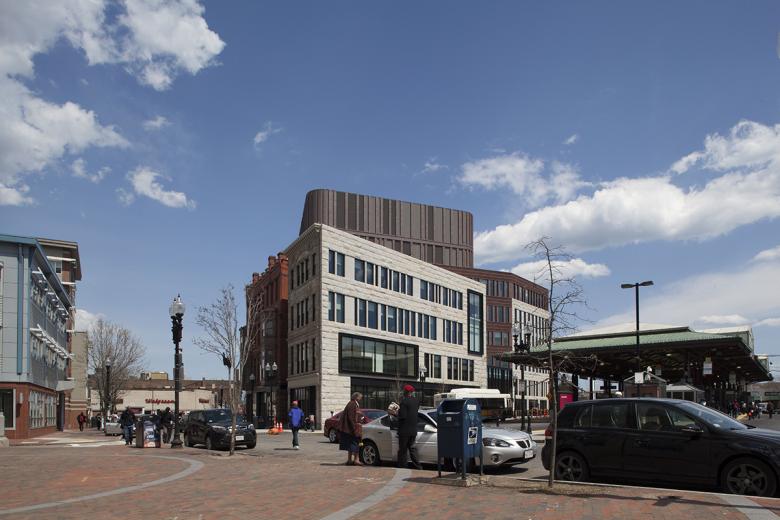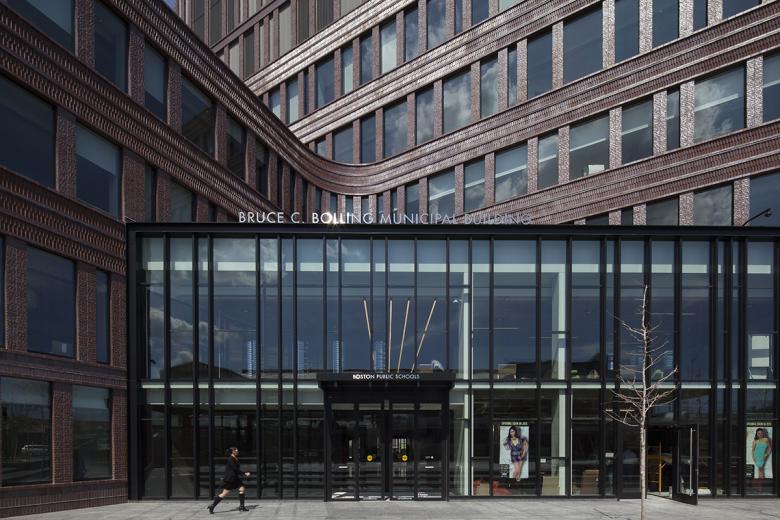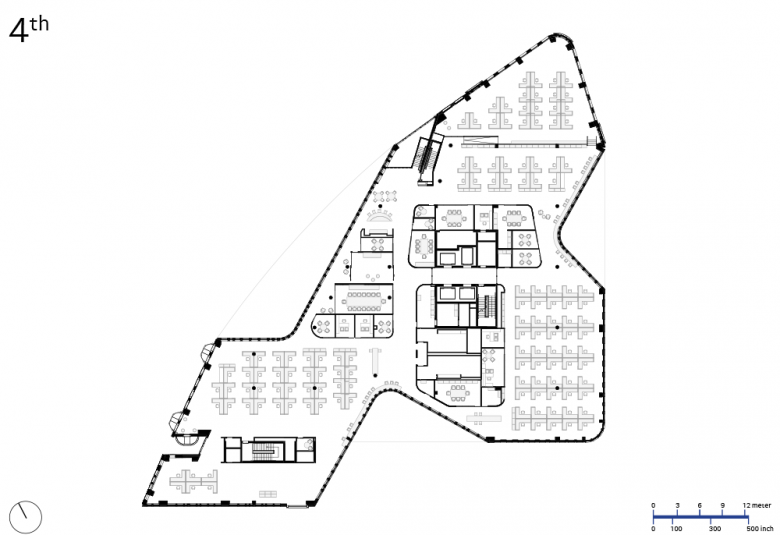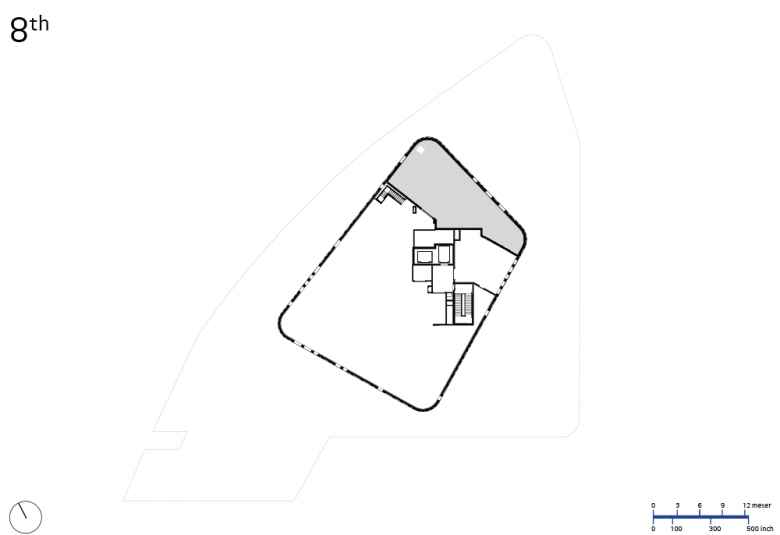Bruce C. Bolling Municipal Building
11. May 2015
Often the best buildings aren't the most flashy or iconic; they are the ones that fit into a city so well they seem to be forever a part of it. This isn't to say that Mecanoo's design for the offices of the Boston Public Schools Division doesn't have contemporary flourishes – those come in the form of creative brickwork and elegantly curved massing. Rather, by reusing and melding three existing buildings, their design makes the new building an integral part of the city, a connection between old and new, and a means of rejuvenating an ailing area. The architects at Mecanoo answered a few questions about the project.
Washington Street corner view
What were the circumstances of receiving the commission for this project?
The building is situated at the center of the neighborhood of Roxbury, near downtown Boston, at the "gravity point" of what is a very green city. When we first visited, we were surprised: we were confronted by a fragmented neighborhood full of empty lots and blank walls following a number of inner-city arson fires, with little greenery in sight.
Nevertheless, we saw a clear and powerful sense of community. For example on many of the blank walls, facing large vacant voids, people had painted enormous murals. Although the center of the city felt empty and in need of patching back together, we immediately saw the potential.
Mayor Thomas M. Menino’s government came to the decision that it would be the responsibility of the City of Boston to redevelop the site. They proposed to consolidate 500 civil servants from the Boston Public Schools Division into a new municipal office building at Dudley Square, in conjunction with a community center and retail space, tied together by a large internal public square. We entered the competition in 2011 and won.
Dudley Square and bus station in 2010
Please provide an overview of the project.
We wanted to unite and re-engage the three existing facades of the neighborhood, reaching back out to all sides of the city. We saw the project as the stitching together of the existing built corners into a bright new building.
The historic facade of the five story limestone and terracotta Ferdinand have been restored and kept as a landmark, returning life to a building intimately linked to the community of Dudley. The facades of the Curtis, in its Queen Anne red brick style, and the Waterman, built in the Boston Granite style, have also been comprehensively restored. They maintain the feel and scale of Dudley Square while injecting a modern aesthetic which is understated in form, yet prominent in the level of craftsmanship employed. Together, these elements create a rich texture both physically and conceptually: a stepped form which respects the historic volumes of the three original structures.
Curtis facade
What are the main ideas and inspirations influencing the design of the building?
Referencing these original buildings, the prevailing thinking during the design phase was that the building should embody a time-honored approach to craft in construction. The form is a contemporary interpretation of classical layering which manifests itself in the brick work, encompassing a number of different masonry techniques from running bond, to stack bond, to soldier bond.
It was designed to have a transparent plinth on ground floor level and a beacon-like crown at the very top, with an extended entablature of masonry in-between. Within the brick facade are elements in relief, casting intricate shadows across one another in a playful, "jazzy" rhythm. Because of the vitreous properties of the brick, the facade reflects light in different ways depending on the weather conditions. Some have described it as "modern Baroque."
Entrance seen from bus station
How did you approach designing for Boston/USA and how would you describe the process of working on the project there?
We approached this project with a typically European attitude to public buildings and public space. We understood that Mayor Thomas M. Menino’s vision to embed a vital piece of the City of Boston—the Public Schools Department—back into Roxbury was sending an important message to the neighborhood and to potential investors in the area. The project was reinstating a civic presence into the the area; it was to be a catalyst for further change.
We wanted to create a building in which all the teachers, children and parents could come to in order to meet, train or receive services—all while creating a friendly, healthy and welcoming public space. We looked at the original site we had been given, which included the historic Ferdinand Building and an extensive empty lot. At the other end of the site sat two other historic buildings—the Waterman and Curtis.
We went to Boston City Hall with a proposition. We petitioned Mayor Menino to expand the ambitions of the project and purchase the derelict Curtis and Waterman Buildings in addition to the Ferdinand. For us, this was simply common sense; it’s a very common urban development model in The Netherlands and across much of Europe. We felt that this would create a more logical plot, allowing us to create a new focal point for the city which is reachable from all three corners of the plot. Menino agreed, and we ended up with the basis for a much stronger building.
New Dudley Square
How would you describe the architecture of Boston/USA and how does the building relate to it?
As the building is at the geographical center of Boston, located at an important city and state transport interchange, it is deeply connected to its city. When we first arrived we were taken by the views of all the blue hills surrounding the city, and decided that we must incorporate a public roof terrace into the building.
The use of bricks is certainly a Dutch import, but the connection between the East Coast of the United States and our country goes back a very long way! It’s Bostonian with a Dutch touch.
Email interview conducted by John Hill.
Office floor
Roof terrace atop Ferdinand
First floor plan
Second floor plan
Third floor plan
Fourth floor plan
Fifth floor plan
Sixth floor plan
Delete me
Bruce C. Bolling Municipal Building
2015Boston, Massachusetts
Client
City of Boston
Architect
Mecanoo
Delft, The Netherlands
Partner Architect, Landscape Architect and Civil Engineer
Sasaki Associates
Historic Preservation Consultant
Building Conservation Associates
Structural, Mechanical and Electrical Engineer
Arup
Lighting Consultant
Lam Partners
Construction Manager
Shawmut Design and Construction
Project Management for Client
PMA Consultants
Building Area
16,700 sm
Photographs and Drawings
Courtesy of Mecanoo
Related articles
-
Spotlight on Italy
on 5/16/18
-
Bologna Shoah Memorial
on 7/20/15













